

How the High Speed Disperser works

The blade rotates at up to 5000 fpm and creates a radial flow pattern within a stationary mix vessel. The blade creates a vortex that pulls in the contents of the vessel to the blades sharp edges. The blade surfaces then mechanically tear apart solids thereby reducing their size, and at the same time dispersing them among the liquid used as the carrier fluid.
High Speed Dispersers are ideal for dispersions that are up to a maximum of approx. 50,000 centipoise. When used in conjunction with Multi-Shaft Mixers, they can be useful up to several hundred thousand centipoise.
Video in Action
This demonstration was conducted on a lab model High Speed Disperser, with the blade immersed in a beaker of water.
As the disperser blade begins to rotate, immediately the vortex begins to pull the water down towards the sharp edges of the blade itself. As the speed of the blade is increased, the full dispersion action can be seen.
Additional Information
Related Articles, Mixing Technology Insights and Whitepapers
Conserve raw materials in a scalable R&D mixer.
Designing high speed dispersers for large-scale mixing processes
High speed mixing: saw-tooth dispersers vs. rotor/stator mixers
How to upgrade your high speed disperser
